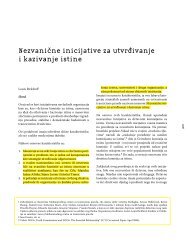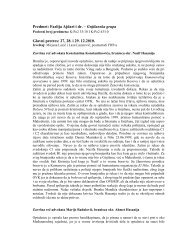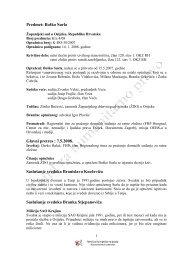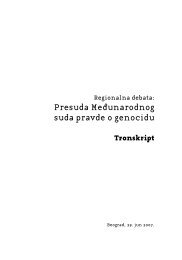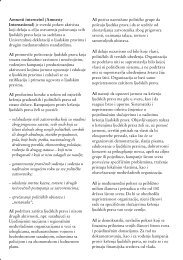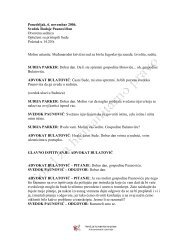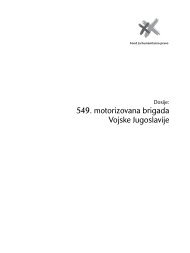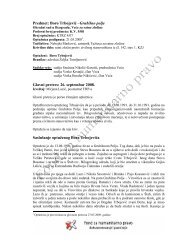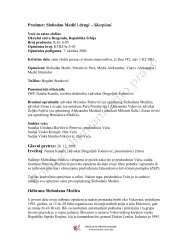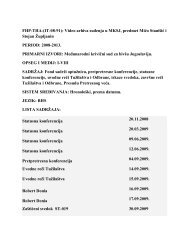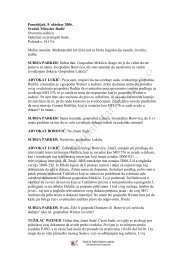here - Humanitarian Law Center/Fond za humanitarno pravo
here - Humanitarian Law Center/Fond za humanitarno pravo
here - Humanitarian Law Center/Fond za humanitarno pravo
You also want an ePaper? Increase the reach of your titles
YUMPU automatically turns print PDFs into web optimized ePapers that Google loves.
The presiding judge, Snežana Nikolić Garotić, pronounced judgment on 19 September 2012,<br />
providing a summary of the reasons the chamber was guided by in making its judgment. She<br />
stated that the moving testimonies of protected witnesses C1 and C2 tallied in their essential parts<br />
– that both of them had been taken from a bread queue on 17 June 1999, that they were beaten,<br />
tortured, raped in the high school dormitory in Gnjilane/Gjilan until 23 June 1999. Their<br />
statements were corroborated by witnesses – the brother and sister-in-law of C1. C1 and C2<br />
clarified why during their first interrogation by the investigative judge of the District Court in Niš<br />
in 2000 they omitted to say that they had been raped. They said that they had not mentioned the<br />
rape because they felt shame; they felt unprotected at the time, w<strong>here</strong>as during these proceedings<br />
they had all the protection they needed. Such an explanation was supported by expert witnesses,<br />
psychiatrists Dr Branko Đurić and Dr Ana Nejman, who indicated that the injured parties come<br />
from a patriarchal community, which often stigmatizes rape victims, holding them responsible for<br />
what had happened to them. In addition, judge Snežana Nikolić Garotić explained the<br />
discrepancies with respect to identification of the perpetrators, a process which had to be repeated<br />
twice, saying that different outcomes were caused by technical deficiencies during identification,<br />
as well as by the fact that during the trial the injured parties had had more time to observe the<br />
defendants and state precisely who had abused them and how.<br />
The court accepted the young age of all the defendants at the time of the crime as a mitigating<br />
factor. The brutality of the crime and persistence demonstrated in its commission were<br />
considered as factors aggravating the guilt of all the defendants.<br />
The defendants were not proven guilty on other charges in the TRZ indictment.<br />
As regards the existence of an armed conflict, it was explained that it had lasted until 20 June<br />
1999. From this date the armed conflict in Kosovo no longer existed because the Serb armed<br />
forces were not present in Kosovo after 20 June 1999 or in Gnjilane/Gjilan after 14 June 1999,<br />
something confirmed by witness testimonies and BIA and VBA reports.<br />
The court did not give credence to any part of the testimony of cooperating witness ‘Božur 50’ 143 ,<br />
because he only stated facts that were common knowledge and he was not a member of the KLA,<br />
something confirmed by VBA, BIA and EULEX reports. The court was not even convinced<br />
whether this witness had ever been in the high school dormitory in Gnjilane/Gjilan. On the basis<br />
of the evidence presented, it was established that the bodies of the victims had not been postmortem<br />
mutilated, incinerated or thrown into the Lake Livočko, as was claimed by this witness.<br />
According to an EULEX report on the search of Lake Livočko, no human remains were found in<br />
the lake. That the bodies of victims were not mutilated and incinerated after death was<br />
corroborated by expert witness testimony. Nothing could be inferred from the testimony of the<br />
143 According to the TRZ indictment, Božur 50 was a KLA member and a co-perpetrator in the crimes set forth in the<br />
indictment.<br />
64




